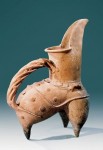Archive for the ‘China’s Cultural Relics’ Category
Origin of Portery Art
 For people in the earliest stage of human development, it is earth on which they lived that gave them the earliest artistic inspiration. That may explains how the earliest pottery was made. The process seems pretty simple: mixing earth with water, shaping the mud by pressing and rubbing with hands and fingers until the roughcast of something useful was produced, placing the roughcast under a tree for air drying and then baking it in fire until it becomes hardened.
For people in the earliest stage of human development, it is earth on which they lived that gave them the earliest artistic inspiration. That may explains how the earliest pottery was made. The process seems pretty simple: mixing earth with water, shaping the mud by pressing and rubbing with hands and fingers until the roughcast of something useful was produced, placing the roughcast under a tree for air drying and then baking it in fire until it becomes hardened.
Before they began producing clay ware, prehistory people had, for many, many millenniums, limited themselves to changing the shapes of things in nature to make them into production tools or personal ornaments. For example, they crushed rocks into sharp pieces for use as tools or weapons, and produced necklaces by stringing animal teeth or oyster shells with holes they had drilled through. Pottery making, however, was revolutionary in that it was the very first thing done by the human race to transform one thing into another, representing the beginning of human effort to change Nature according to Man’s own design and conception. Prehistory pottery vessels are crude in shape, and the color is inconsistent because their producers were yet to learn how to control the temperature of fire to ensure quality of what they intended to produce. Despite th at, prehistory pottery represents a breakthrough in human development.
Regretfully, scholars differ on exactly how and when pottery – making began. According to a most popular assumption, however, prehistory people may have been inspired after they found, by accident, that mud-coated baskets placed beside a fire often became pervious to water.
View of China’s Cultural Relics
The Chinese civilization is one of the four most ancient in the world. Relative to the Egyptian, Indian and Tigris-Euphrates civilizations, it is characterized by a consistency and continuity throughout the milleniums. Rooted deep in this unique civilization originating from the Yangtze and Yellow River valleys, a yellow race known as the “Chinese” has, generation after generation, stuck to a unique cultural tradition. This tradition has remained basically unchanged even though political power has changed hands numerous times. Alien ethnic groups invaded the country’s heartland numerous times, but in the end all of them became members of a united family called “China”.
Cultural relics, immeasurably large in quantity and diverse in variety and artistic style, bespeak the richness and profoundness of the Chinese civilization. These, as a matter of fact, cover all areas of the human race’s tangible culture. This book classifies China’s cultural relics into two major categories, immovable relics and removable relics.”Immovable relics” refer to those found on the ground and beneath, including ancient ruins, buildings, tombs and grotto temples. “Removable relics” include stone, pottery, jade and bronze artifacts, stone carvings, pottery figurines, Buddhist statues, gold an silver articles, porcelain ware, lacquer works, bamboo and wooden articles, furniture, paintings and calligraphic works, as well as works of classic literature. This book is devoted to removable cultural relics, though from time to time it touches on those of the first category.
Far back in the 11th century, when China was under the reign of the North Song Dynasty, scholars, many of whom doubled as officials, were already studying scripts and texts inscribed on ancient bronze vessels and stone tablets. As time went by, an independent academic discipline came into being in the country, which takes all cultural relics as subjects for study. New China boasts numerous archeological wonders thanks to field studies and excavations that have never come to a halt ever since it was born in 1949. This is true especially to the most recent two decades of an unprecedented construction boom in China under the state policy of reform and opening to the outside world, in the course of which numerous cultural treasures have been brought to daylight from beneath the ground?
Readers may count on this book for a brief account of China’s cultural relics of 12 kinds – pottery, jade artifacts, bronze ware, figurines, carvings on stone tablets, murals, grottoes and formative art of Buddhism, gold and silver artifacts, porcelain, furniture, lacquer works, and arts and handicrafts articles. We’ll concentrate, however, on the most representative, most brilliant works of each kind while briefing you on their origin and development.
Unfortunately, we can not show you all kinds of cultural relics unique to China, for example those related to ancient Chinese mintage,printing and Chinese classics, traditional Chinese paintings and calligraphy. To cite an old Chinese saying, what we have done is just “a single drop of water in an ocean.” Despite that, we hope you’ll like this websit, from which we believe you’ll gain some knowledge of the traditional Chinese culture.